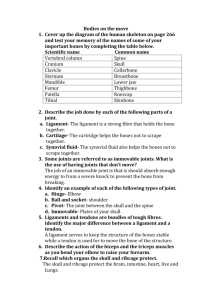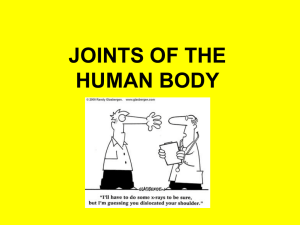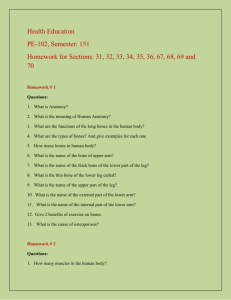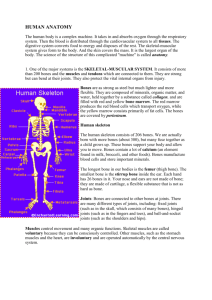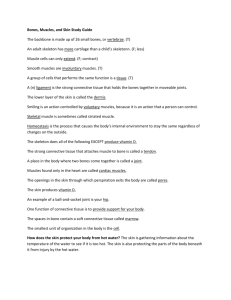COMPARING HUMAN BODY SYSTEMS TO NONHUMAN SYSTEMS
advertisement
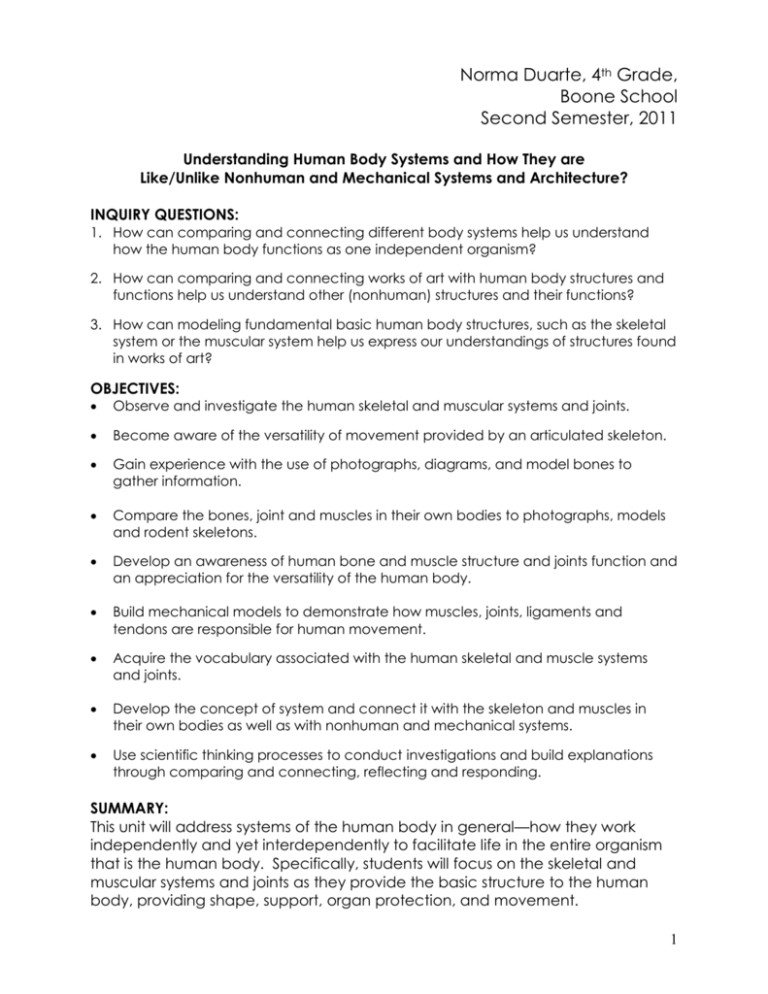
Norma Duarte, 4th Grade, Boone School Second Semester, 2011 Understanding Human Body Systems and How They are Like/Unlike Nonhuman and Mechanical Systems and Architecture? INQUIRY QUESTIONS: 1. How can comparing and connecting different body systems help us understand how the human body functions as one independent organism? 2. How can comparing and connecting works of art with human body structures and functions help us understand other (nonhuman) structures and their functions? 3. How can modeling fundamental basic human body structures, such as the skeletal system or the muscular system help us express our understandings of structures found in works of art? OBJECTIVES: Observe and investigate the human skeletal and muscular systems and joints. Become aware of the versatility of movement provided by an articulated skeleton. Gain experience with the use of photographs, diagrams, and model bones to gather information. Compare the bones, joint and muscles in their own bodies to photographs, models and rodent skeletons. Develop an awareness of human bone and muscle structure and joints function and an appreciation for the versatility of the human body. Build mechanical models to demonstrate how muscles, joints, ligaments and tendons are responsible for human movement. Acquire the vocabulary associated with the human skeletal and muscle systems and joints. Develop the concept of system and connect it with the skeleton and muscles in their own bodies as well as with nonhuman and mechanical systems. Use scientific thinking processes to conduct investigations and build explanations through comparing and connecting, reflecting and responding. SUMMARY: This unit will address systems of the human body in general—how they work independently and yet interdependently to facilitate life in the entire organism that is the human body. Specifically, students will focus on the skeletal and muscular systems and joints as they provide the basic structure to the human body, providing shape, support, organ protection, and movement. 1 Students will investigate the human skeletal and muscular systems and joints to understand their roles in the structure of the human body. They will compare human systems to works of art to seek out and reflect on relationships between them. Working in groups of 3-5, students they will respond to works of art by writing and acting out their own interpretations of connections they see between them. Students will compare the human body to a machine, a house, and other objects of their own choice. They will question the different ways these relationship can be established and make concrete comparisons between them and particular human body functions. Students will compare the human body to architectural forms through graphic organizers, collages and descriptive paragraphs. Students will apply connecting-comparing; reflecting-responding to bone shapes and explain what they could become. Students will view a DVD about the barn owl and how they produce pellets. They will read about the barn owl in addition to other informational material about the human body. They will respond to their reading through journal entries, writing summaries, group and whole class discussions. Works of art—Angry Young Machine Time Transfixed Whirligig Cronopios: Florencia Pita TIMELINE: Approximately 5-6 weeks 2 UNDERSTANDINGS A system is several parts working together to do one job. Students demonstrate an understanding of human body systems by … o Showing connections between external body structures (our physicality) and internal (skeletal, joint, muscular) systems and how they help us function and survive. o Comparing and analyzing external features and characteristics of humans and other animals. o Recognizing relationships/similarities between anatomical features and their functions and nonhuman objects such architectural structures and works of art and their functions. o Creating Venn diagrams to compare/contrast/connect human body systems with nonhuman systems PART ONE: Bones Comparing and Connecting. Students observe specific movements of the body while jumping rope. They list “what moves” in their partner’s body while jumping. They respond to their observations by explaining why they are able to jump. How they believe the system works. They connect their findings with their own body by feeling their own bones. They work in groups to estimate the number of bones in their own bodies. Students observe/study skeleton photos and diagrams to obtain a more accurate estimate of the number in the human body and the skeletal layout. They assemble a card stock articulated skeleton without a guiding model, rather based on their own understanding of the function of each skeletal part. They dissect and examine an owl pellet to compare human bones to rodent bones. Using bone sorting charts, they compare benchmark bones such as the skull, mandible, teeth, femur, tibia fibula, and pelvis they find in their pellet to identify animal skeletons. They select and assemble one of the skeletons. They must explain what bones in particular helped them decide they type of animal skeleton they found. Part of the pellet investigation process requires that students describe (size, shape, texture) compare (it looks/reminds me of) connect (I have seen/read/done) reflect (how the pellet was produced, how much the owl ate, its diet, these bones are sort of like mine) respond (yuck, it’s sterilized, cool, I want/don’t want to do this because..) to the pellet itself and the experience). 3 In what ways are the skeletons of a rodent and a human similar? They reflect and respond to: In what ways are the skeletal systems of these two species alike/different? Why? What makes is necessary for each to be as it is? Why? What parts (if any) make the striking differences—such as hands vs. paws, ability to walk upright vs. on all fours, teeth to bite and chew, vs. teeth and claws to rip/tear? Comparing Bones How do leg bones from different animals differ? How are they alike? PART TWO: Joints UNDERSTANDINGS The place where two bones come together is called a joint. Articulated means jointed or joined in sections. An opposable thumb is positioned opposite the other fingers. Articulated hands with opposable thumbs are essential for performing intricate tasks. The human skeleton has three basic types of joints: hinge, ball-and-socket, and gliding. These joints allow the body to move in different ways. o Ball and socket—can move in all directions—up, down, front and back Locations—shoulder and , hip o Hinge—open and close or move back and forth Elbow, knee, toes, finger, and thumb o Gliding—side-to-side, move in two directions but do not rotate Wrist, ankle, neck, and all others Joints are classified by the amount of movement they allow. Some joints move freely, some move a little and some never move. Students investigate the meaning of “articulated skeleton.”—When a hard skeleton is able to bend it is called articulated. First, they try to locate and count the joints in their own bodies. Second, they explore a model skeleton and with the goal of identifying the joints more accurately. Third, they identify joints on a diagram of a skeleton and tell what type each is. Students categorize the types of joints in the body and compare the movement of mechanical devices to the function of human joints. Students explore objects that represent joint types, Door hinge: hinge joint—knee, elbow Measuring spoon and mallet: ball and socket joint—hip, arm 4 Students identify joints in classroom objects and in the building, for example, windows are examples of gliding joints; doors are examples of hinge joints; door knobs are examples of ball and socket joints; corners are examples of immovable (fused) joints like the joints in the skull Looking at Thumb Joints: Students investigate the important of the opposable thumb. They immobilize their thumbs by taping them to their index finger with masking tape. They attempt to perform a specific set of tasks in attempt to answer the following questions: How important are thumbs for doing everyday activities? What tasks are difficult to do without thumbs? Students try to hold a pencil and follow a maze; button and unbutton, zip and unzip clothing, tie a shoe; write their name, address, and phone number; pick up dimes. Doing Joint Tasks: Students investigate the importance of hinge joints for doing everyday tasks. They immobilize the hinge joints in their index and middle fingers and their wrists by taping them to am 8 inch dowel and then attempt to perform specific tasks such rolling a newspaper and placing a rubber band around it; folding a letter and placing it in an envelope; cut paper with scissors; Naming Joints: Students name joint types by applying Post-it notes to classroom skeleton and explain how each joint type allows movement. What are the three main types of joints that allow movement? Students connect the flow and “movement” of Florencia Pita’s Cronopios to the concept of a system of joints. They discuss in groups; write descriptive paragraphs, and present to class. ASSESSMENT: Students demonstrate their understanding of bones and joints by using plastic bones to construct two different animal legs—a chicken leg (two bones) and a rodent leg (three bones), Students observe the model bones before completing the Bone Lab Sheet Students should notice that in the chicken leg, the tibia-fibula is larger than the Students must apply what they have learned about bones and joints—shape of bone is related to the joint—and figure out how the bones fit together correctly Students must explain, illustrate and label their solutions and answer questions on lab sheet. 5 PART THREE: Muscles UNDERSTANDINGS Over 630 muscles move the human body Muscles can only pull (contract and relax). They do not push to push. Muscles usually work in pairs-one to pull in one direction and the other to pull in the opposite direction. Muscles attach to bones with tissue called tendon. Ligaments attach bone to bone. Some ligaments serve as guides through which tendons run. Muscles control so many movements in the body, that without them, we would not be able to live. Muscles are voluntary—work at persons command and involuntary—work without being “told to.” Students observe the action of muscles that cause the body to move. Students review lesson one when they observed each other’s body movements while jumping rope. They discuss what made their bodies move—how their muscles work in their bodies. They review their science notebook entries to discuss: Where muscles can be found in their bodies. They feel the various muscles in their bodies, including their jaw, lower arm, upper leg and calf Muscles work in pairs, not alone When muscles work, they contract and become harder or shorter Bones are pulled toward each other when a muscle contracts Teacher shows illustration of a leg muscle on overhead projector Identify tendons at ends of muscle—they attach muscles to bone. Students identify this muscle and tendon on their own legs and feel how it stretches all the way out. Students stand on tip toes and feel how the muscle and tendons become hard as they are stretched. Students try to find other working muscles in their bodies, such as their arms, abdomen, backs, faces, etc. ASSESSMENT: Students build operational models of leg and thumb to demonstrate how muscles move these and other body parts First, students build a mechanical model of a leg in order to demonstrate how muscles move feet and legs. They use wood dowels, rubber tubes, rubber bands, and paper clips. They are given these materials but must decide which items represent the various parts of the leg. For example, one rubber tubing represents the knee, while another represents the ankle; a popsicle stick represents the foot, while the two wood dowels represent the tibia fibula and femur. The rubber bands represent the muscles and the paper clips represent the tendons. 6 Students simulate muscle contractions by pulling the rubber bands to make the knee bend and move the leg. Students build goal nets and play desk-top soccer with their leg models. Students receive an illustration of the human body with labeled muscular system. They now begin to identify names of muscles with muscles they have identified in their bodies and in the leg models they built, e.g., tibialis, biceps Students build a model of a thumb and complete a muscle response lab sheet, Again, they identify the corresponding parts of the thumb represented by the dowels, tubing, and string. They are introduced to the term ligaments. They compare the movement of their own thumbs with the movement of their models. Key concept: Ligaments connect bone to bone Sometimes ligaments act as guides for tendons Students consider and free write: Where in nature (not animals) they might find objects (or systems) performing the jobs/tasks of “bones, joints, muscles, tendons”? What in nonliving things have parts that could function as muscles—what parts in a nonliving thing allow it to move? 7 Art Focused Lesson Angry Young Machine PART ONE Students compare and contrast this work of art with the human skeletal and muscular systems. They work in groups to list ways to connect how the “Machine” might function like and unlike of human body systems. They respond to the object by giving it two names—as it compares and as it contrasts a system. Students reflect on the work by writing about and illustrating their ideas in short descriptive paragraphs. PART TWO: Unit Wrap-up Students will construct a graphic organizer from construction paper. First, they will fold the paper in half (vertically). Second, they will fold it into fourths. Third, they will cut four slits half way up horizontally to create four flaps. On each flap they will write one of the critical thinking concepts—compare, connect, reflect, respond They will choose one of the three works of art —Angry Young Machine, Time Transfixed, or Whirligig and apply the critical thinking concepts to it. They will illustrate their ideas and write brief statements, ideas, phrases, etc corresponding to each critical thinking concept and the work of art. Students will share their work with the class. ANGRY YOUNG MACHINE Compare Connect Reflect Respond 8 René Magritte Belgian, 1898–1967 Time Transfixed, 1938 1970.426 Frank Memkus American, 1884-1965 Whirligig, entitled "America", c. 1938/42 1980.166 H. C. Westermann American, 1922-1981 Angry Young Machine, 1959 9 RESEARCH: Students groups will choose a body system to research Although the joints are not considered a body system, for the purpose of this project, they will be referred to as the joint system. Students will produce a Body System Brochure that will include: Definition of system and parts Main function of system and each major part How the system’s function is independent yet interdependently of other body systems Diagram main parts and system as a whole Write an “Important Poem” about their system Identify parallels between the body and a house See student research guide at end. Students will select two works of art and have one write a letter to the other explaining how it is like a system. 10 POSSIBLE EXTENSIONS LESSON FOR HIGH END DIFFERENTIATION 4. COORDINATION Students investigate hand and foot response time by using a falling-cup device. They take turns releasing the cup and trying to move their hand (or foot) from the path of the cup. Results are recorded and compared. Students repeat the coordination investigations to evaluate the effect of practice on response time. Coordination is when parts work together to complete a task. A stimulus is something that triggers a response. A stimulus is often information received through the senses. A response time is the length of time it takes for a person to respond to a stimulus. Students will consider the relationship between the following concepts: Since “A stimulus is something that triggers a response.” and “A stimulus is often information received through the senses.” They will discuss/explain why and how this works when viewing works of art. They may write descriptive paragraphs, perform a skit, or other response. Students work in groups to answer: If you were to pair two works of art with the goal of working together to perform a task, which two would you pair? Why? What task would they perform? 11 Human Body System Research Worksheet Group Members: ______________ _____________ _____________ _____________ ______________ Our Group’s Body System is the ________________________________________________ Assignment: The job of your group is to research the body system you have been assigned. Take notes that will help you answer the questions below about that body system. Use the internet and books to find facts. Remember to note where you get your information. You will need it for your bibliography. You will use the information you gather to create a brochure about the system you researched. Your brochure will include informational paragraphs, graphics, a short rap or song, and an Important Poem. You may use other creative ideas to make your brochure interesting and fun. Your group will present the brochure you create to the class. Use the worksheet below to guide you in your research. EVERYONE PARTICIPATES. NO OBSERVERS! You will be given more information about how to format your brochure after you have gathered all of the research. What is the main function of this system? What are the main parts of this system? 12 What does each part do? How does this system affect other body systems? How do other body systems affect this system? What are some diseases of this system? 13 How can this system be affected by outside, environmental factors (for example, pollution, smoking, lack of exercise)? What are some fun facts about this system? How is this system like a house? 14 Explain why and how. If your system were part of a house, what part of the house would your system be? ____________________________ System Try illustrating it your idea. Body System House 15 Make a connection between the body system you researched and one of these works of art. Name of work of art: ____________________________ Connection: Time Transfixed Whirligig Angry Young Machine (transfixed: to shock or terrify somebody so much that they cannot move ALSO, to pierce something with a weapon or other sharp weapon or object) Resources (websites and print sources used): 1. ___________________________________________________________________ 2. ___________________________________________________________________ 3. ___________________________________________________________________ 4. ___________________________________________________________________ 16 STANDARDS ADDRESSED: Science 11.A.2e Report and display the results of individual and group investigations 12.D.2b Demonstrate and explain ways that forces cause actions and reactions (e.g., magnets attracting and repelling; objects falling, rolling and bouncing). Drama 25.A.2b: Understand the elements of acting, scripting, speaking, improvising, physical movement, gesture, and picturization (shape, line, and level); the principles of conflict/resolution and theme; and the expressive characteristics of mood and dynamics 25.B.2 Understand how elements and principles combine within an art form to express ideas. 26.A.2b Describe various ways the body, mind and voice are used with acting, scripting and staging processes to create or perform drama/theatre. 26.B.2d Demonstrate knowledge and skills to create works of visual art using problem solving, observing, designing, sketching and constructing Language Arts CC.4.W.4 Production and Distribution of Writing: Produce clear and coherent writing in which the development and organization are appropriate to task, purpose, and audience. (Grade-specific expectations for writing types are defined in standards CC.4.SL.1 Comprehension and Collaboration: Engage effectively in a range of collaborative discussions (one-on-one, in groups, and teacher-led) with diverse partners on grade 4 topics and texts, building on others’ ideas and expressing their own clearly. CC.4.SL.1.a Comprehension and Collaboration: Come to discussions prepared, having read or studied required material; explicitly draw on that preparation and other information known about the topic to explore ideas under discussion. CC.4.SL.4 Presentation of Knowledge and Ideas: Report on a topic or text, tell a story, or recount an experience in an organized manner, using appropriate facts and relevant, descriptive details to support main ideas or themes; speak clearly at an understandable pace. CC.4.SL.6 Presentation of Knowledge and Ideas: Differentiate between contexts that call for formal English (e.g., presenting ideas) and situations where informal discourse is appropriate (e.g., small-group discussion); use formal English when appropriate to task and situation. (See grade 4 Language standards 1 and 3 on page 28 for specific expectations.) CC.4.L.3 Knowledge of Language: Use knowledge of language and its conventions when writing, speaking, reading, or listening. CC.4.L.3.a Knowledge of Language: Choose words and phrases to convey ideas precisely.* CC.4.L.3.c Knowledge of Language: Differentiate between contexts that call for formal English (e.g., presenting ideas) and situations where informal discourse is appropriate (e.g., small-group discussion). Research Standards—to follow 17



